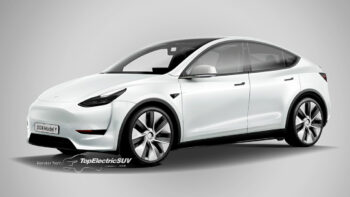Update: ‘Production’ section updated.
Tesla has revolutionized the global electric mobility movement with its quirky and efficient passenger vehicles. In November 2017, Tesla co-founder and CEO Elon Musk announced plans to enter the commercial transport industry with the Tesla Semi electric truck. On December 1, 2022, after many hiccups and delays, Tesla finally kicked off deliveries of the Semi in the United States.
The Semi is not just any truck; it’s a zero-emissions freight-hauling cargo machine that trumps traditional oil guzzlers on all fronts like range, economy, operational costs, and performance. Here’s everything we know about the Tesla Semi as of today:
Tesla Semi Design
There’s a unique cab construction for the Tesla Semi and arguably the cleanest design we have seen on a truck. It appears as if it belongs to the future. There’s a massive wraparound glass area upfront that slopes into the frunk. The glass area is so large, that its panels extend to the doors. Tesla dropped door mirrors on the Semi for aerodynamic benefits. Instead, cameras positioned at the extreme rear send a feed to the interior screens. However, it’s not carrying that feature into production, as seen in the new official pictures used in this story.
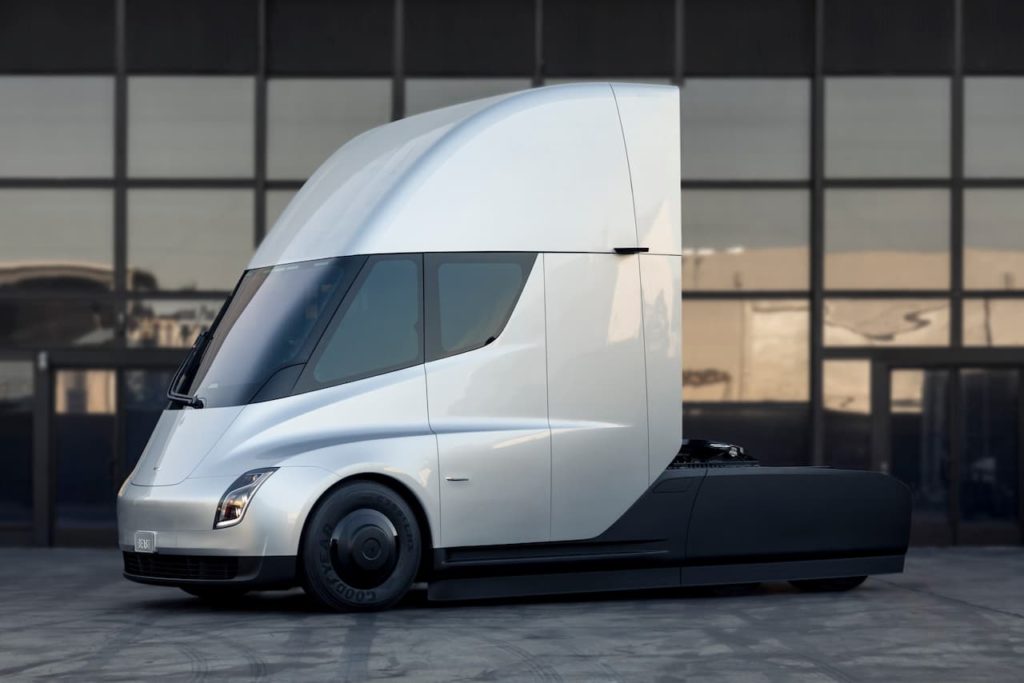
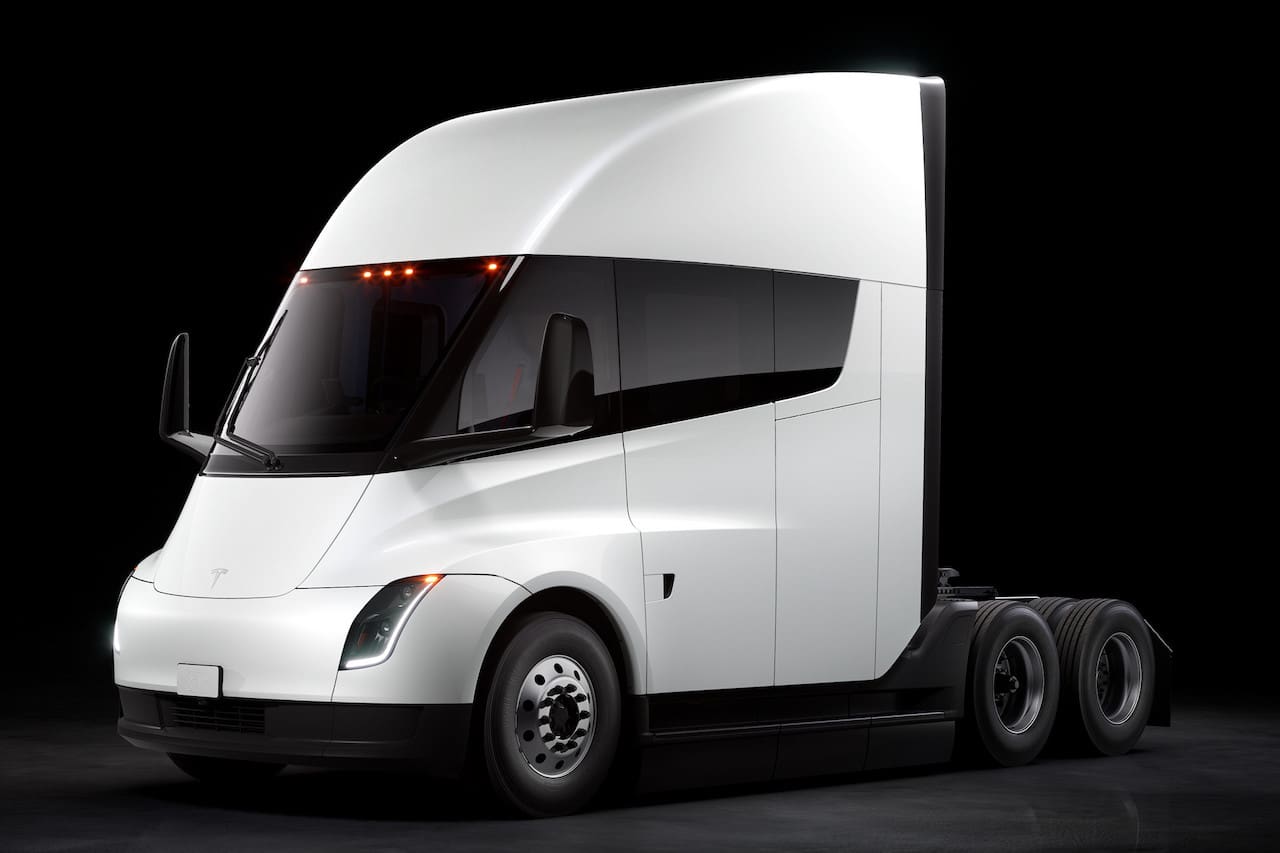
Diesel trucks usually have enormous grilles to maximize airflow to the high cubic capacity engines. The Tesla Semi, being an EV, has its nose blanked off, while its chin houses a relatively small air intake to cool the battery, which sits between the front and rear axles. It has one axle on the front and two axles at the rear, making for a 6×4 tractor layout. The rear houses the trailer bed and the tow hitch.
Musk made significant claims about the aerodynamic capabilities of the Tesla Semi, explaining its smooth surfacing and clean overall design.
The truck is designed like a bullet. The Tesla Semi has a 0.36 drag coefficient. Better than the Bugatti Chiron, which has a 0.38 coefficient of drag. The aerodynamics help it achieve an incredible range.
Elon Musk, co-founder and CEO, Tesla, at the Tesla Semi & Roadster unveil in 2017.
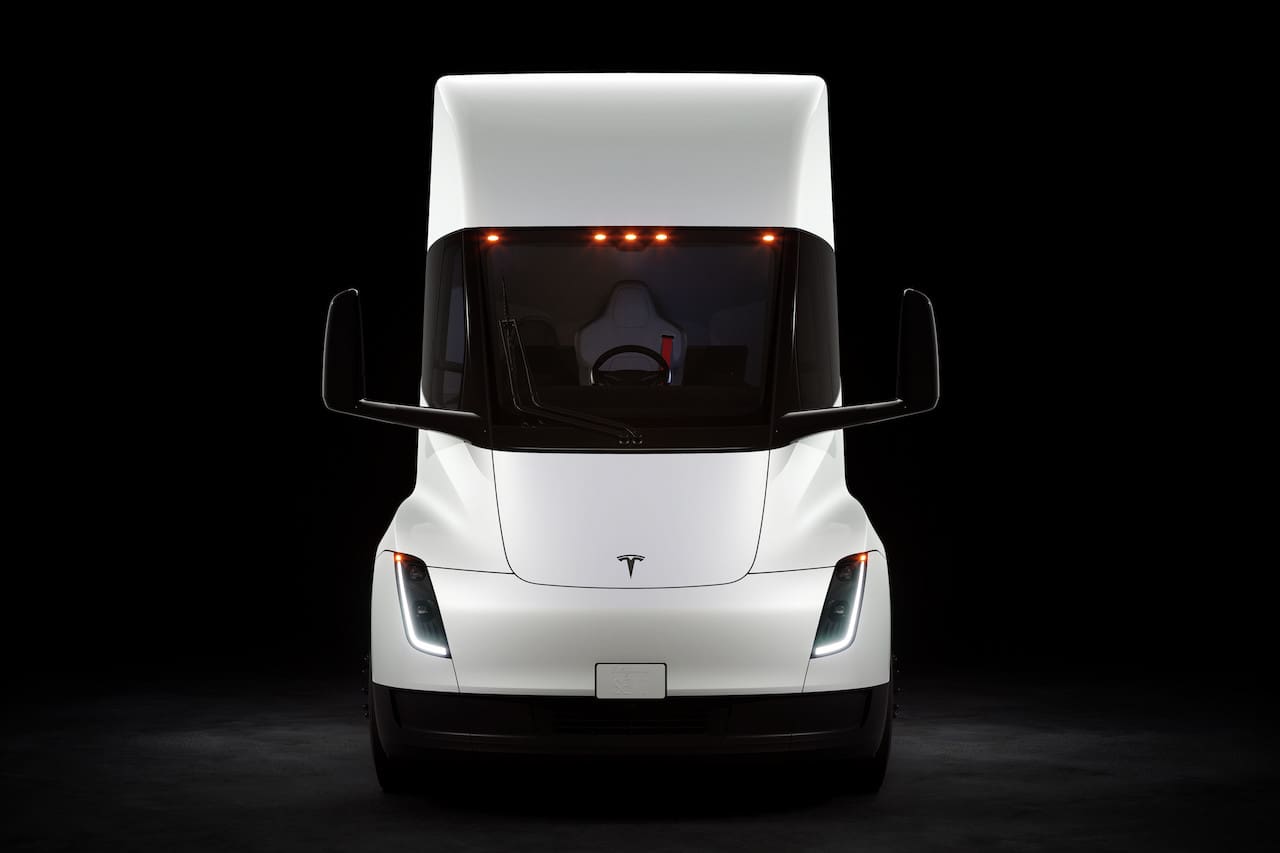
Frito-Lay & Pepsi’s Semi spotted in California
Most pictures we have seen of the Tesla Semi consist of the trucks finished in an all-white or silver shade. Not the least bit drab, but within expectations. However, Frito-Lay has been using its Semi in and around California, and its paint scheme is anything but ordinary. Video footage of these big boys driving around Modesto, California, has cropped up on the Tesla Owners Silicon Valley Twitter page.
Tesla Semi for @Fritolay spotted in Modesto by one of our members. This beast is going to change trucking forever. pic.twitter.com/Ws9OnmhTf7
— Tesla Owners Silicon Valley (@teslaownersSV) December 15, 2022
Painted in the brand’s popular bright red and yellow livery, these trucks sport an enlarged “Frito-Lay” font printed at the front, just above the massive windscreen. There’s more company branding printed just aft of the driver’s cab area, while the company’s famous Chester Cheetah mascot has been painted onto the trailer for increased visibility.
Then we have footage posted by Reddit user Tutrifor, showing a PepsiCo-branded Semi where we can see the Pepsi logo at the front, with a couple more presented on either side of the main cab. The livery comprises the company’s easily recognizable hues of blue. The trailer also sports shades of blue, plus some ‘feel-good’ slogans on each side to really drive home the point of these massive electric vehicles. Both of these Tesla Semis are eye-catching, to say the least.
Specifications
The Tesla Semi has a Day Cab that usually allows a shorter and lighter body compared to a Sleeper Cab, leading to lower energy consumption. In a Jay Leno’s Garage episode (via YouTube) that premiered on October 2, 2023, Dan Priestley, Senior Manager – Semi Truck Engineering, Tesla, said that Tesla will release a Semi with a sleeper cab when it expands the charging network.
Tesla has launched the Semi with a tri-motor powertrain. A quad-motor powertrain option will likely become available later. Reports say the Semi’s battery pack, positioned under the cabin floor, has an energy storage capacity of 850-1,000 kWh, enough to power ten units of Tesla Model X! Tesla typically doesn’t disclose the battery pack capacity of its EVs, and it’s the same case with the Semi.
1,000-volt electrical system
Tesla thinks switching from a 400-volt architecture to an 800-volt architecture for midsize and smaller models like the Model 3, Model Y, and Tesla RoboTaxi would be costly. However, the higher system voltage makes sense for larger applications like the Cybertruck and Semi, Baglino said during the company’s Q1 2022 earnings conference call on April 20, 2022.
On bigger EVs, where there’s a requirement for higher charging power, higher power from the battery to power the power electronics, or more torque, enough semiconductor savings are possible by opting for 800 volts instead of the usual 400 volts, Baglino explained. In addition to consistent high performance and reduced charging time, an 800-volt system would reduce the weight and installation space of the cabling.
In the case of the Semi, Tesla has gone for not even 800, but 1,000 volts! The Class 8 truck is the company’s first model with a four-digit operating voltage. “There’ll be more vehicles coming with that (1,000 volts),” Priestley said during the Semi delivery event.
Performance & Capabilities
Tesla hasn’t revealed the power or torque figures. However, we know that electric vehicles develop a wealth of torque, so we expect the Semi’s powertrains to produce four-digit torque figures. In the Jay Leno’s Garage episode, Priestley said that the Semi’s powertrain has about 1500 system horsepower, but Tesla limits the power that goes to the wheels to increase range. Additionally, Priestley indicated that reducing some of that high-end power improves the life of the Semi’s tires.
Tesla uses the tri-motor powertrain of the Model S Plaid and Model X Plaid in the Semi. This powertrain consists of a Highway Drive Unit (efficiency motor) mounted on one axle and two Acceleration Drive Units (performance motor) mounted on the other axle.
The Highway Drive Unit is constantly engaged, and the Acceleration Drive Units engage only when needed, ensuring maximum efficiency. Speaking of efficiency, the tri-motor Semi consumes less than 2 kWh per mile. That’s when it’s fully loaded at 82,000 lbs. (gross). On August 2, 2023, Dejan Antunović, Electrification Program Manager, PepsiCo, said that (via Vimeo) the company has been able to run its Tesla Semis at less than 1.7 kWh per mile for the past several months.
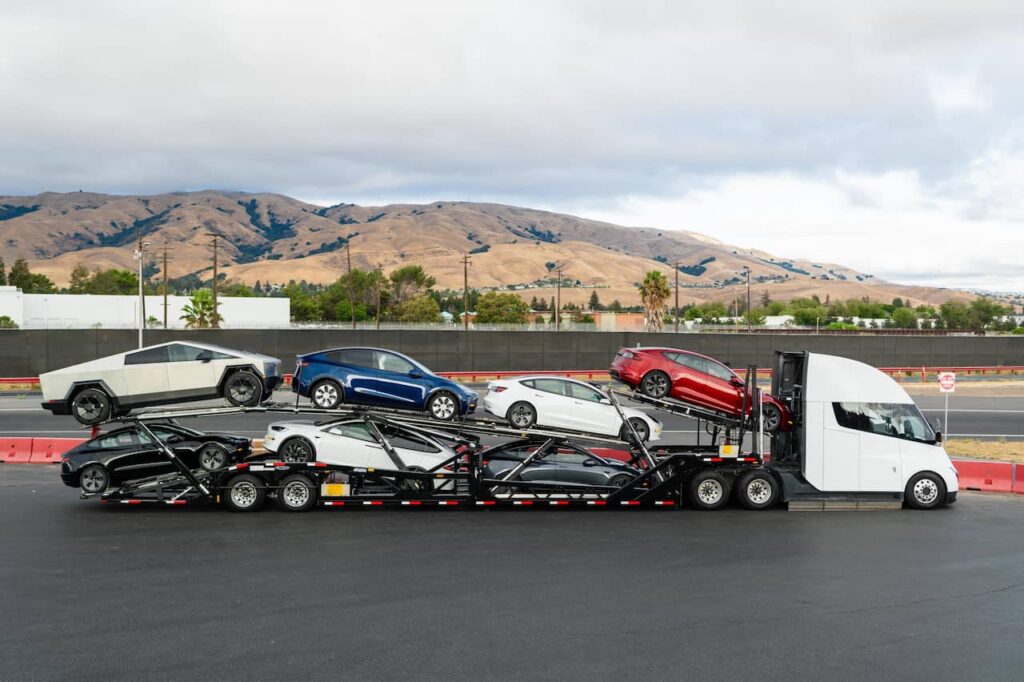
A fully loaded, tri-motor Semi at 82,000 lbs. gross combination weight takes 20 seconds to accelerate from 0 to 60 mph. It can attain highway speeds up a 5% gradient. During the Semi delivery event, Tesla showed a video of a fully-loaded tri-motor Semi (82,000 lbs.) easily speeding up and overtaking a regular semi on the Donner Pass at a 6% incline.
A Semi quad-motor with 80,000 lbs. also takes 20 seconds to accelerate from 0 to 60 mph. Without the payload, the Semi quad-motor could accelerate like a mid-range sports car with a 0-60 mph time of just around 5 seconds. According to the brand’s presentation, a regular diesel truck takes 15 seconds. Moreover, the Semi quad-motor can drive up to speeds of 60 mph up a 5% gradient.
There’s no doubt that the Semi will make the job of truckers considerably easier and less stressful. Drivers new to the profession may learn quicker and with less effort than in a conventional, diesel-powered semi. On October 30, 2022, X user HinrichsZane posted a video showing a Semi quickly accelerating after gradually stopping and turning at a roundabout in Silver Springs (Nevada).
When Jay Leno drove the Tesla Semi (without a trailer), he felt that “it doesn’t feel clumsy or unwieldy.” The driver doesn’t get the feeling of being in some huge truck, he added. Priestly told him that the turning radius of the Tesla Semi is about the same as the Model 3 or Model Y, which makes it easy to maneuver in urban areas. Further into the drive, while changing the lane, Leno said that the electric semi truck felt quite nimble.
Towards the end of the drive, Leno did some hauling with the Tesla Semi, transporting a low-roof Tesla Semi on a trailer. He said that he didn’t feel like he was pulling anything. “We’re pushing a good load back there – 60-70,000 pounds gross vehicle weight,” Priestly said in response.
It’s as easy to drive as a Model 3. With basically no training, you can drive this.
Elon Musk, co-founder and CEO, Tesla (Tesla Semi Delivery Event on December 1, 2022)
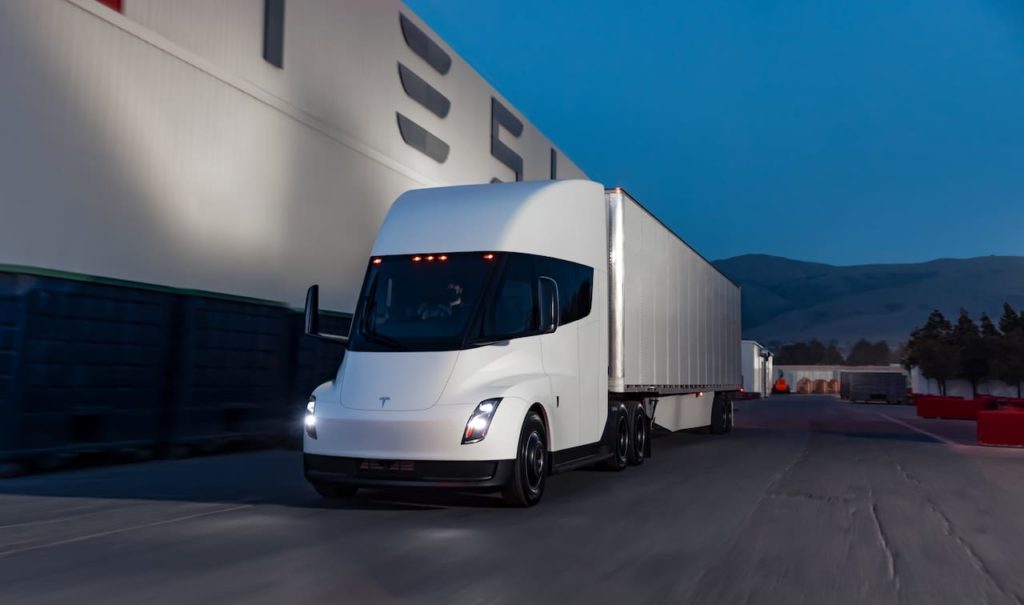
500 miles of range
For truckers, the range would be a primary concern. Tesla has addressed range anxiety comprehensively. There are versions of the Semi, one that provides 300 miles of range and one that delivers 500 miles. Tesla is first shipping the 500-mile Semi. The timelapse video embedded below shows a fully loaded (82k lbs. gross), tri-motor Semi driving 500 miles on a full charge:
Video Source: YouTube/Tesla
The claimed figure seems more than adequate given the United States’ rules for truckers. In the USA, truck drivers are legally required to take a 30-minute break after 8 hours of driving, according to the United States Department of Transportation. 400 miles is the distance truckers typically cover in 8 hours, approximately, according to Tesla.
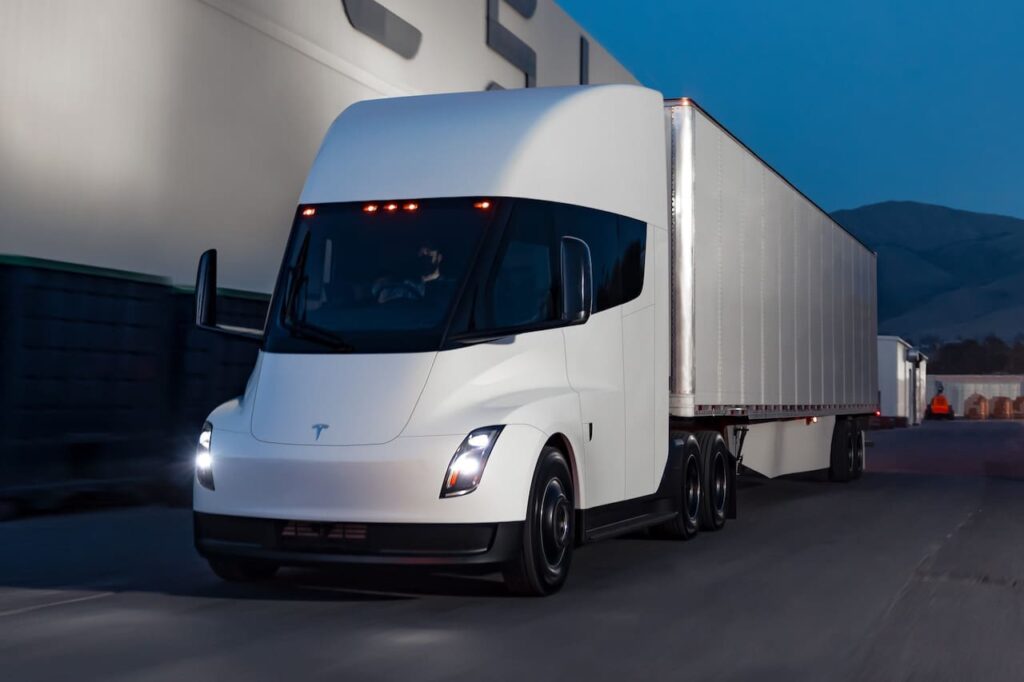
North American Council for Freight Efficiency (NACFE) is conducting a ‘Run on Less – Electric DEPOT’ event with 21 electric trucks, including three Tesla Semis, from September 11 through 30. It is tracking the activity of these trucks and also looking at their total depot electric energy and fuel per day to know the electrical energy consumption equivalent. The Tesla Semis are being tracked in heavy-load long-haul transport operations at PepsiCo’s Sacramento, California depot.
One of the Tesla Semis covered a combined distance of nearly 1,700 miles during a 48-hour period during the event. On day 10 (via NACFE), truck #1 conducted four deliveries and traveled a distance of 841 miles, with 91% of the road driven at 50+ mph. It spent 70.4% of the time on the road and 7.7% of the time charging. On day 11 (via NACFE), the number of deliveries went down to three but the distance traveled was longer –853 miles, with 91.5% of the route covered at 50+ mph. 68% of the time went in driving, and only 5.57% in charging. While we’re yet to get the complete results as the event is yet to finish, it’s not hard to tell how practical the Semi is in the real world.
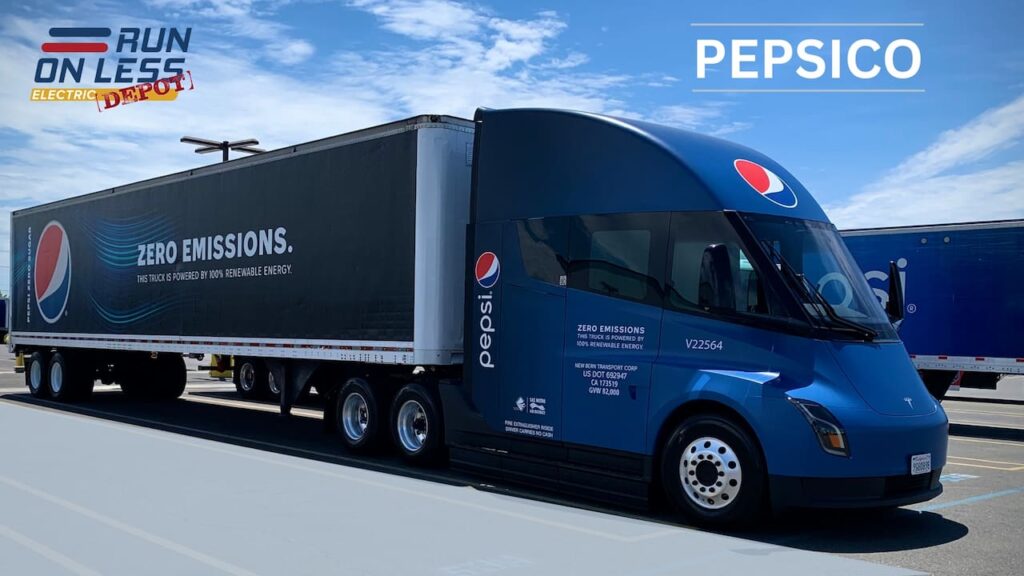
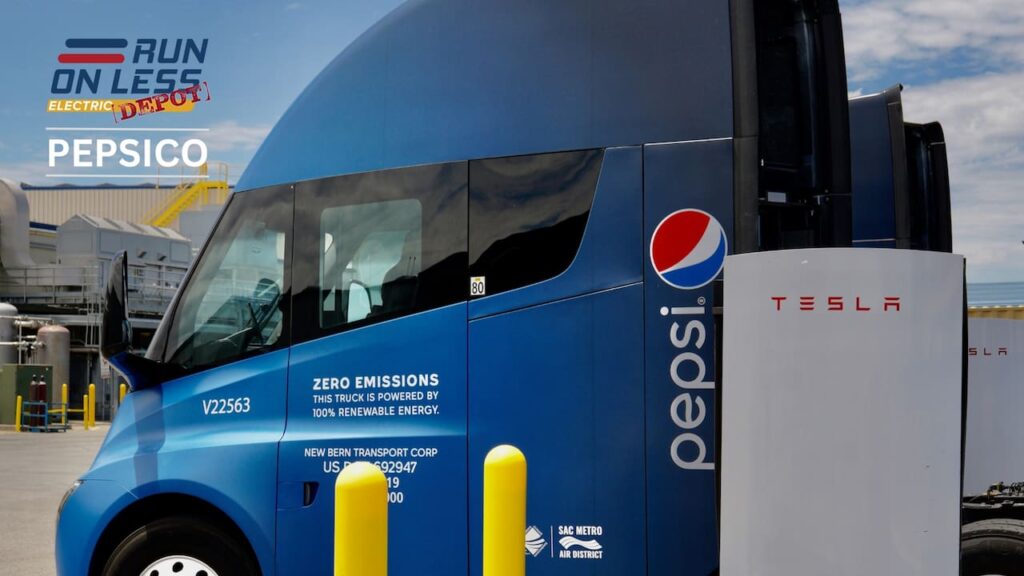
300-mile-range variant
On April 3, 2023, Tesla released Part 3 of its Master Plan long-term strategy. The company indicated that the 300-mile range of the Semi will use a Lithium Iron Phosphate (LFP) battery pack instead of a high-nickel Lithium-ion battery pack, with an energy storage capacity of 500 kWh. The company anticipates cumulative global sales of 6.7 million units for this ‘Semi Light’ over a lifetime.
Tesla Megacharger
The Tesla Semi has a massive battery pack that requires more charging time and faster-charging speeds. However, Tesla has a solution—Megachargers. For long-distance journeys to be sustainable for truckers, the brand is building a network of Megachargers at trucking rest stops across the U.S. and Europe, as revealed in its Impact Report 2020. Since the report is over a year old, we wonder how far Tesla has come with the Megacharger network.
The Semi supports charging at 1 megawatt, which is insane compared to current electric vehicle charging rate standards! Charging on direct current at a Tesla Megacharger to 70% SoC takes just 30 minutes, which is enough for the driver to take a short break and refresh but not unnecessarily long. However, no motoring journalists or range-testing organizations have reviewed the Semi to verify the claim.
There’s an 11-hour driving limit and a 14-hour duty limit in the USA, including non-driving activities like unloading the cargo. Truck drivers are also required to take 34 hours of rest at the end of every working week. If the carriers don’t comply with these rules, driving privileges can be revoked, penalties are charged, and the carrier’s safety rating suffers.
While creating their own charging network, Tesla and other automakers have asked the U.S. government to invest in charging infrastructure for medium- and heavy-duty electric vehicles like trucks and buses. These companies want the Biden administration to allocate 10% of the money for EV charging in the USD 7.5 billion-bipartisan infrastructure bill (signed in November 2021) to charging infrastructure for medium- and heavy-duty EVs. Most existing EV charging infrastructure is designed to cater to passenger models and vans, and so, the larger commercial vehicles need establishments designed as per their requirements.
The Tesla Megacharger offers high-capacity charging, and to deal with the excessive heat generated during the process, it features liquid cooling. The Cybertruck will also benefit from this charging technology, Musk revealed during the Semi delivery event.
4680 Cells
It was widely anticipated that the Tesla Semi would use 4680 cells, at least in one version. However, Musk has confirmed that Tesla does not use 4680 cells in the Semi.
The Semi doesn’t use 4680s.
Elon Musk, co-founder and CEO, Tesla (Q3 2022 earnings conference call on October 19, 2022)
A 4680 cell measures 80 mm in length and around 46 mm in diameter, hence the 4680 name. At the Tesla Battery Day 2020, Andrew Baglino, the company’s Senior Vice President for Powertrain and Energy Engineering, said that 4680 cells give five times the energy, six times the power, and a 16% higher range as compared to the current cells.
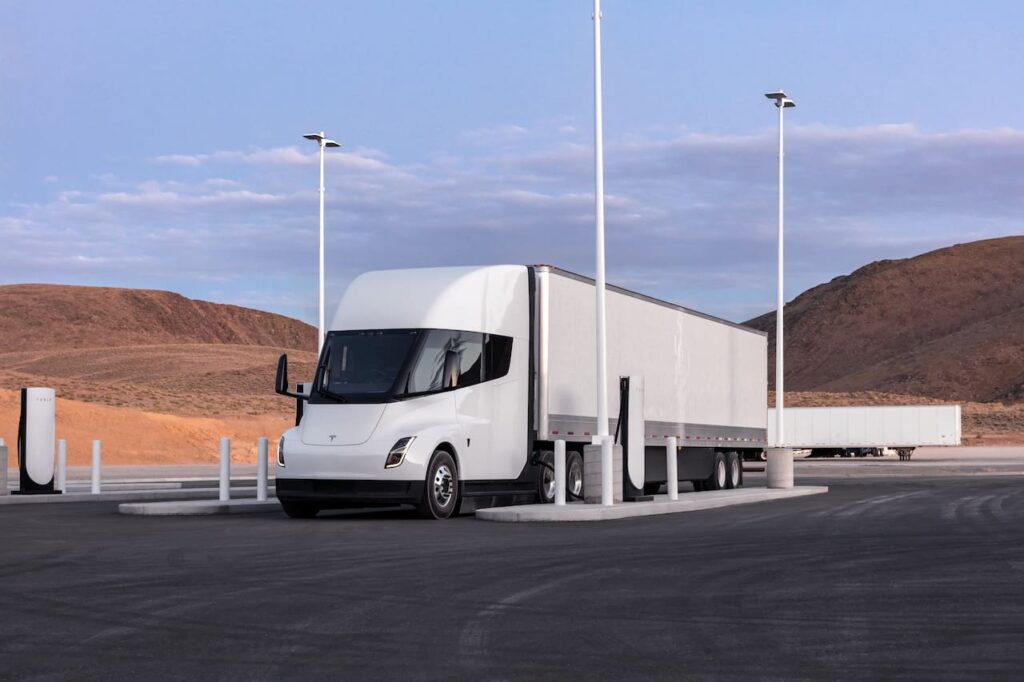
Tesla is making as many as 868,000 units of the new cells, as per a post it shared on X on December 25, 2022. As big as that number sounds, it’s only enough to manufacture 1,000+ EVs (Model Ys).
| Aspect | Tesla Semi Specifications |
| Drag Coefficient | 0.36 Cd |
| Powertrain | 3 or 4 independent motors on rear axles |
| Range | 300 or 500 miles |
| Acceleration 0-60 mph (with payload) | 20 seconds |
| Speed up a 5% grade | 65 mph |
| Energy consumption | Less than 2 kWh per mile |
| Fuel savings | More than USD 200,000 |
Interior & Features
The interior is unique. The driver’s seat is centrally positioned, and Tesla says this allows better overall visibility out of the windshield. It features a red seatbelt. Behind the driver’s seat, there are two additional foldable seats. There are two massive touchscreens on the two extreme ends of the dashboard. Expect these two screens to feature Tesla’s brilliant UI and the usual suite of connectivity offered in its road cars, in addition to truck-specific features that showcase trailer data and more.

Thanks to the Tesla Mobile application, there is a full suite of remotely controlled features. Owners can remotely access diagnostics, location tracking, and communication for Dispatch. There’s the predictive maintenance feature also where the system analyses the health of the truck and alerts the owner when it’s time for a service. Fleet owners can also access this extensive data without any hassle.
Safety
Another area where the Tesla Semi breaks significant ground is safety. The Tesla Semi was slated to feature the brand’s ‘Enhanced Autopilot’ suite of features as standard. We are yet to get a confirmation if that has actually happened. The range of safety features includes automatic emergency braking, forward collision warning, and automatic lane-keeping assist. If the Tesla Semi senses no driver input, it stays in the lane, comes to a slow and gradual halt, and automatically dials an emergency number.
There’s an enhanced traction control system on the Tesla Semi to prevent jackknifing. Jackknifing refers to the unusual folding of highly articulated vehicles like trailers because of uncontrolled inertia. It occurs when the heavy trailers cause the truck to contort to awkward angles, often causing accidents. Tesla’s engineers have incorporated an advanced traction control system where jackknifing is wholly avoided.
Additionally, the Tesla Semi’s drivetrain is guaranteed to last one million miles. Even if two of its motors break down, the Tesla Semi can still function and beat a diesel truck in acceleration and range. What’s more? Musk claimed that the Semi would require no brake pad changes ever. Brake energy regeneration, which recovers kinetic energy and stores it in an electrical form in the battery, naturally slows the vehicle down.
Automatic Tire Inflation System
Tesla could offer the Semi with an Automatic Tire Inflation System (ATIS), as per a report from Electrek. The company has received USPTO’s grant for the patent for this technology, which could automatically revise the tire pressure and keep it at the optimum level. Electrek has seen the patent application and says that it mentioned John Furtado as the inventor of the technology. Furtado has worked on the Semi’s brake controls, brakes, pneumatics, tires, wheel ends, and wheels.
An ATIS is not a new technology, but Tesla is improving it. Its version of the ATIS substantially reduces contamination in the air stream. As the air stream is purer, the ATIS’ life increases, and it requires maintenance less frequently.
Thermonuclear explosion-proof glass
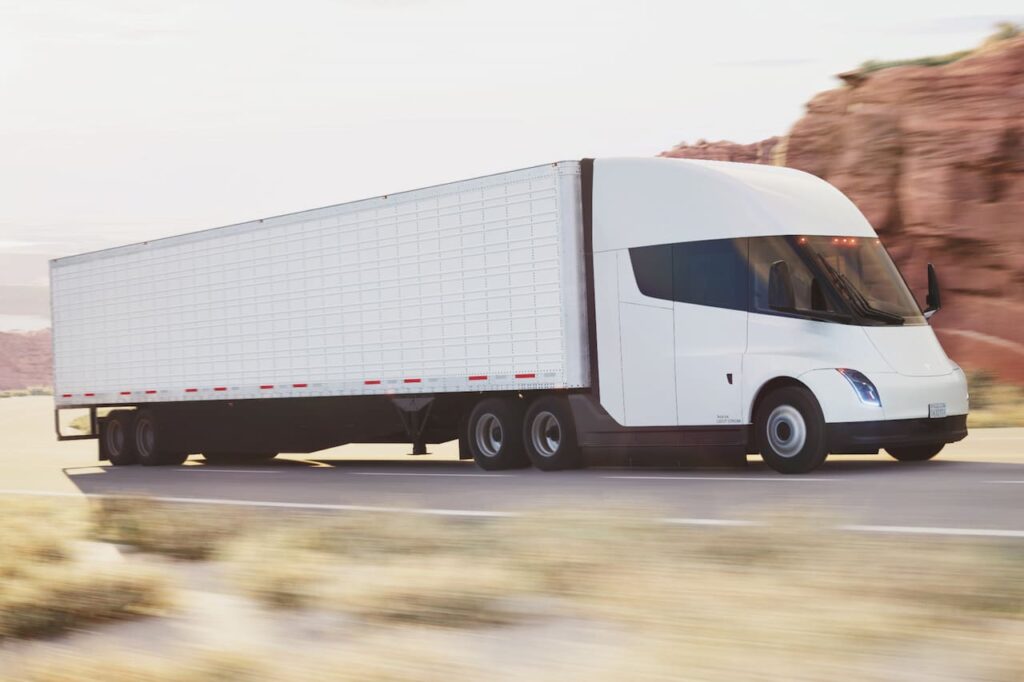
That’s not it. The large glass area on the Tesla Semi is no ordinary kit. It’s what Tesla calls ‘thermonuclear explosion-proof glass’ offered as standard. According to the CEO, truck glasses are enormous, and they break once a year on average. If the glass breaks, drivers cannot use the truck because of apparent safety and visibility concerns, resulting in revenue loss and inconvenience to customers. Tesla’s thermonuclear explosion-proof glass would eliminate these issues.
Price & Rivals
At launch, Tesla delivered the first two units of the Semi to PepsiCo, one with blue paint and Pepsi branding, and the other in yellow sporting Frito-Lay livery. However, the company hasn’t disclosed pricing.
In a video NACFE released on August 2, 2023, (via Vimeo), Amanda DeVoe, Transformation and Strategy Director, PepsiCo Fleet, said that the company has received 21 Tesla electric semis and also associated four 750 kW chargers, electric yard tractors, E-Transits, and electric forklifts. “We deliver predominantly under a hundred miles on a daily basis and run those vehicles around 12 hours a day,” she added. DeVoe also revealed that three of PepsiCo’s 21 Tesla Semis are dedicated to long-haul routes of 250-450 miles.
PepsiCo uses its electric semi trucks to deliver on routes that are mostly under a hundred miles, for around 12 hours a day, DeVoe said. Using BEVs with that duty cycle gives it the most advantage in its decarbonization strategy, she added.
Antunović said that three of the company’s 21 Tesla Semis are dedicated to long-stance routes of 250-450 miles. Further, while talking about the benefits of regenerative braking in PepsiCo’s delivery operations, he said that the company has found it very useful in increasing efficiency. He cited the example of a trip from Sacramento to Nevada and return, during which it was able to zero out in terms of charging level improving due to regenerative braking.
On April 18, 2023, Reddit user asymptotally spotted a Pepsi-branded Semi on the street. The driver apparently told the Redditor that it was his first day driving the all-electric truck and that he had received an hour of training before the drive. He found the ride to be smooth, and the only issue that he faced was the difficulty of using the Tesla app.
Initially, when Tesla planned to offer the Semi with a quad-motor powertrain, it expected USD 150,000 (300-mile version)/USD 180,000 (500-mile version) to be the base price. On October 19, 2022, during the company’s Q3 2022 earnings conference call, Musk said that the Semi will be much costlier than a passenger vehicle. Reservations for the Semi are on pause.
I don’t want to say the exact prices, but they’re much more than a passenger vehicle. So, with a few thousand heavy trucks of this nature would be worth several Model Ys.
Elon Musk, co-founder and CEO, Tesla (Q3 2022 earnings conference call on October 19, 2022)
Tesla says that diesel trucks are 20% more expensive in terms of operational costs. The Tesla Semi costs USD 1.26 per mile, while an average diesel truck costs USD 1.51 per mile. Tesla says the figures were calculated using a 100-mile route, 60 mph average speed, 80,000 pounds payload, USD 2.50 gallon diesel, and 7 cents per kWh electricity price. The point the company is trying to make is that the electric truck’s high initial price can be recovered by low operational costs and minimal maintenance costs.
Rivals of the Tesla Semi include the Volvo VNR Electric, Freightliner eM2, Kenworth T680E, and Peterbilt 579EV.
Production
Production of the Tesla Semi takes place at Gigafactory Nevada. The company started with the 500-mile variant, and it could add the cheaper, 300-mile variant when it ramps up production. On May 16, 2023, at Tesla’s annual shareholder meeting, Musk said that the company is expanding Gigafactory Nevada for the Tesla Semi production line and also for in-house production of 4680 cells.
Tesla still manufactures the Semi in limited numbers. In the Jay Leno’s Garage episode (via YouTube) that premiered on December 18, 2023, Lars Moravy, VP of Vehicle Engineering at Tesla, revealed that the company has close to 100 Semis in its fleet now. He said that volume production of the Semi will commence in 2024. Previously, during Tesla’s Q3 2022 earnings conference call, Musk said that Tesla is tentatively aiming for 50,000 units in 2024.
In January 2023, Tesla announced it would invest USD 3.6 billion in Gigafactory Nevada. A big portion of this investment will go into a new high-volume Semi factory, and the construction of this plant has started, Tesla confirmed during its Q4 2023 earnings conference call on January 24, 2024. The availability of the Semi would significantly improve once the new factory is ready and operating at full steam.
A sizable chunk of the USD 3.6 billion investment will go into even a 100 GWh 4680 cell factory—enough to power 1.5 million light-duty EVs annually. Tesla should begin using 4680 cells in the Semi when output increases and stabilizes. Lastly, a portion of the USD 3.6+ billion investment will go into adding 3,000 new employees as well.
Large order book
Tesla seems to have a sizable order book for the Semi, and customers are eagerly waiting for deliveries. PepsiCo has pre-ordered 100 trucks, Sysco has ordered 50 units, Anheuser-Busch has ordered 40 units, Walmart is awaiting 130 trucks, and Pride Group Enterprises has ordered 150 trucks. Pride Group Enterprises announced in November 2020 that they paid the booking amount to reserve initial units and build slots. The orders are just a fraction of these companies’ fleets.
According to a report Reuters published on December 16, 2023, PepsiCo will put 100 Tesla Semis into service in 2023 and use them for delivering products to customers like Walmart and Kroger. The company will deploy 15 units from Modesto and 21 from Sacramento, Vice President Mike O’Connell said in an interview, as per the report. There’s no word on the other locations, but the company wants to start using the electric truck in the central U.S. next, followed by the East Coast.
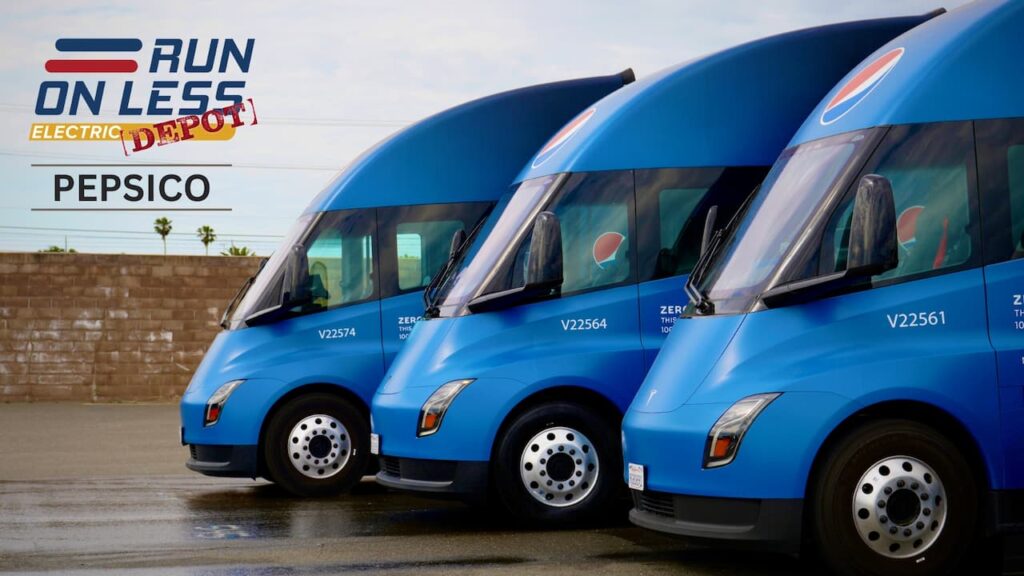
All of Pepsico’s Tesla Semis have a 500-mile range, as per the Reuters report. The Frito-Lay division will use them for trips of around 425 miles. The company will use the electric truck for delivering heavier loads of beverages to only those locations that are around 100 miles away, though, O’Connell said. Eventually, the Semis will serve destinations “in the 400 to 500-mile range as well,” he added.
According to a report by Drive Tesla Canada dated January 6, 2022, the company has installed its first 1.5-megawatt Megachargers at Frito-Lay’s facility in Modesto. O’Connell said that it will install four 750 kW chargers each at PepsiCo’s Modesto and Sacramento facilities.
Another Tesla Semi order of a significant quantity is from Orlando-based start-up EV Semi-Fleet. The new trucking company has ordered 50 units already and says (on evsemifleetcorp.com) it plans to reserve “thousands more.” The asset-based carrier will be hiring CDL drivers to move freight for distribution centers with the Tesla Semi trucks. It has raised USD 1.1 million for the first 50 Semis, which it plans to use at Tampa and Jacksonville ports, as per a report from Commercial Carrier Journal.
Tesla Semi in Canada
In the report published by Teslarati on December 9, 2022, indications of Tesla Semis reaching Canadian shores officially are becoming increasingly clear. With the country’s government preparing to finalize its Federal Budget for 2023, a proposal letter apparently landed on the desk of Chrystia Freeland, Deputy Prime Minister and Minister of Finance of Canada.
While the letter purportedly mentions the Canadian Government’s intent to implement a program specifically for medium and heavy electrified transport vehicles, Tesla is also urging the nation’s leaders to focus on the necessary EV infrastructure required to support future EV growth and their permanence in the market.
Despite the lack of a strong charging network at the moment, some Canadian companies have already placed their orders for the semi-truck, evidence of actual interest from key players in the commercial industry.
More electric semi trucks on the way
Electric semi truck customers will have more options in the near future. Volvo Trucks has started selling the Volvo FH Electric with a range of up to 300 km (186 miles). A Mercedes eActros Longhaul (eActros 600) that can travel up to 500 km (311 miles) on a full charge is scheduled to enter series production at the end of 2024, Mercedes-Benz Trucks CEO Karin Rådström announced during its world premiere on October 10, 2023.
TopElectricSUV says
The Semi is a groundbreaking semi-truck that could make trucking significantly easier, more comfortable, and safer than traditional semi-trailer trucks currently on the market, including the ones converted from diesel to electric. It should be considerably cheaper to run and maintain, too. As a bonus, in the words of Elon Musk, the zero-emission Class 8 semi-truck is “super fun to drive.”
Tesla Semi FAQs
What is the Tesla Semi release date?
Tesla Semi deliveries have begun in the U.S. market, though in limited numbers.
What is the Tesla Semi price?
The Semi quad-motor is expected to cost USD 150,000 in the 300-mile range variant & USD 180,000 in the 500-mile range variant.
Which electric semi-trucks are Tesla Semi rivals?
The Volvo VNR Electric, Freightliner eM2, Kenworth T680E, and Peterbilt 579EV are alternatives to the Tesla Semi.
Featured image source: Tesla
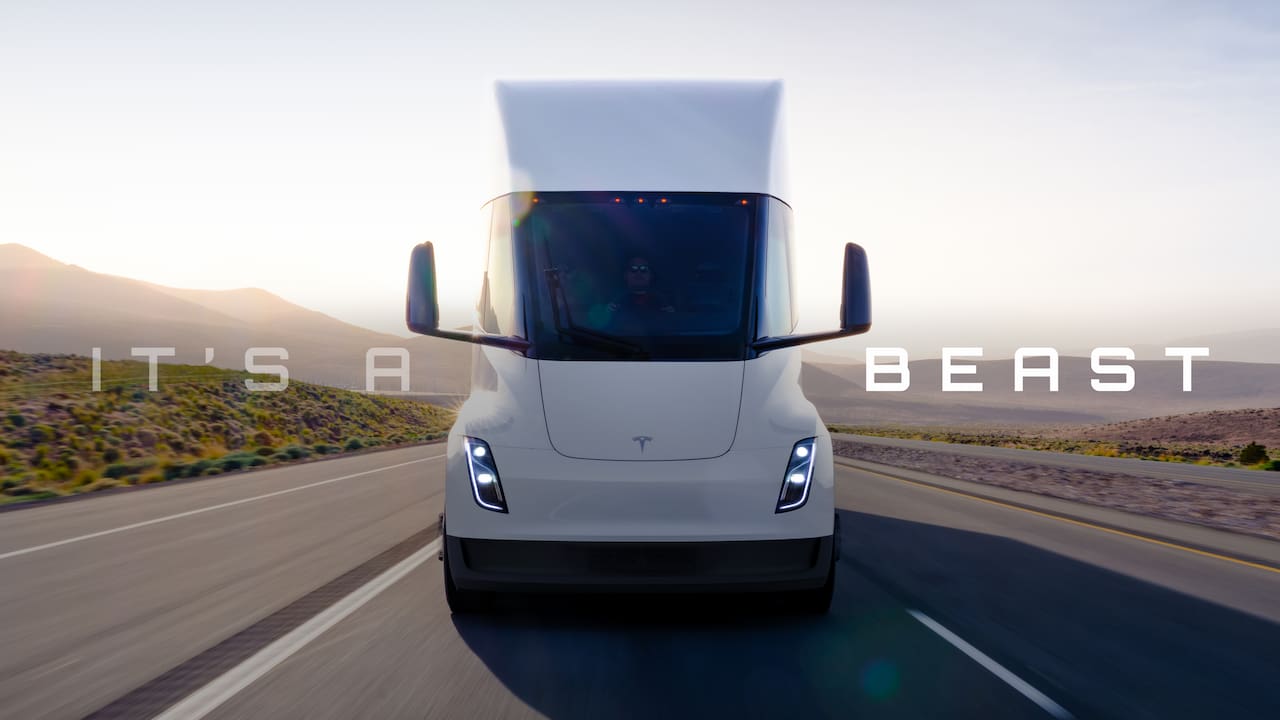

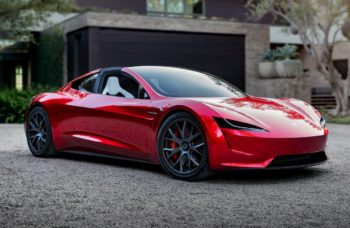
![USD 25000 ‘Tesla Model 2’ or ‘Model Q’ proposed in 6 designs [Update]](https://topelectricsuv.com/wp-content/uploads/2021/11/Tesla-Model-Q-rendering-350x184.jpg)
